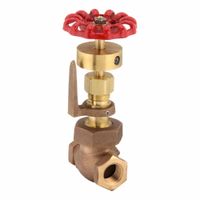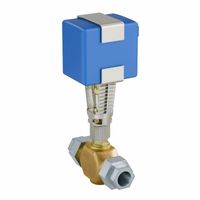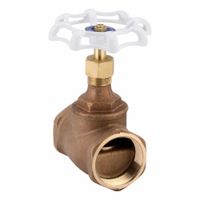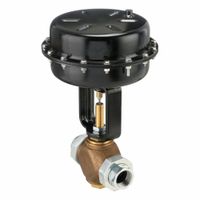Call +(254) 703 030 000 / 751 483 999 / 721 704 777
- Home
- Plumbing
- Plumbing Valves
- Throttling Valves
- Globe Valves
Frequently Asked Questions
What is a globe valve and how does it work?
A globe valve is a type of valve used to regulate flow in a pipeline. It consists of a movable disk-type element and a stationary ring seat in a generally spherical body. The valve's name is derived from its spherical body shape, although modern globe valves may not have a spherical shape.
The primary function of a globe valve is to start, stop, and regulate flow. It operates by the movement of the disk against the flow stream. When the valve is open, the disk is lifted from the seat, allowing fluid to pass through. When closed, the disk is pressed against the seat, stopping the flow. The flow path through a globe valve is more tortuous than through other types of valves, which results in higher pressure drops.
Globe valves are typically used in applications where flow control is necessary, such as in cooling water systems, fuel oil systems, and feedwater or chemical feed systems. They are suitable for both throttling and shut-off applications.
The valve is operated by a handwheel or actuator connected to a stem, which moves the disk up or down. The stem is threaded, and as the handwheel is turned, the stem moves linearly, raising or lowering the disk. This linear motion provides precise control over the flow rate, making globe valves ideal for applications requiring frequent operation and precise flow regulation.
Globe valves can be designed for various pressure and temperature conditions and are available in different materials to suit specific applications. They are known for their good shut-off capabilities and are commonly used in industries such as oil and gas, water treatment, and chemical processing.
What are the advantages of using a globe valve for flow control?
Globe valves offer several advantages for flow control:
1. **Precise Flow Regulation**: The design of the globe valve, with its linear motion and perpendicular disc movement to the flow, allows for precise control over flow rates. This makes it ideal for applications requiring accurate flow modulation.
2. **Good Throttling Capability**: Globe valves are well-suited for throttling applications. The valve's design allows for a wide range of flow control, from fully open to fully closed, providing excellent throttling performance.
3. **Minimal Leakage**: The seating arrangement in globe valves ensures a tight seal when closed, minimizing leakage. This is particularly beneficial in applications where leakage could lead to safety hazards or product loss.
4. **Versatility**: Globe valves can handle a variety of fluids, including gases, liquids, and steam. They are suitable for high-pressure and high-temperature applications, making them versatile across different industries.
5. **Durability**: The robust construction of globe valves, often made from materials like stainless steel or brass, ensures durability and a long service life, even in demanding conditions.
6. **Ease of Maintenance**: Globe valves are relatively easy to maintain. The valve's design allows for straightforward access to internal components, facilitating repairs and reducing downtime.
7. **Bidirectional Flow**: While primarily designed for unidirectional flow, globe valves can handle flow in both directions, adding to their flexibility in system design.
8. **Reduced Cavitation**: The design of globe valves helps reduce cavitation, a common issue in flow control that can cause damage to the valve and piping system.
These advantages make globe valves a preferred choice for applications requiring reliable and precise flow control.
How do you install a globe valve in a pipeline system?
1. **Preparation**: Ensure the pipeline is depressurized and drained. Verify the valve specifications match the system requirements.
2. **Orientation**: Identify the flow direction indicated by an arrow on the valve body. Install the valve so that the flow enters the valve from below the seat.
3. **Positioning**: Place the valve in the pipeline with the stem vertical. This ensures proper operation and prevents debris accumulation.
4. **Alignment**: Align the valve flanges with the pipeline flanges. Ensure there is no misalignment to prevent stress on the valve and pipeline.
5. **Gasket Installation**: Place appropriate gaskets between the valve and pipeline flanges. Ensure they are clean and undamaged.
6. **Bolting**: Insert bolts through the flange holes. Tighten them in a crisscross pattern to ensure even pressure distribution. Use a torque wrench to apply the recommended torque.
7. **Support**: Provide adequate support for the valve and pipeline to prevent stress and vibration. Use pipe hangers or supports as necessary.
8. **Inspection**: Check for proper installation, alignment, and support. Ensure there are no visible leaks or misalignments.
9. **Testing**: Gradually pressurize the system and check for leaks. Operate the valve to ensure smooth functioning.
10. **Documentation**: Record the installation details, including valve type, location, and any observations during installation.
11. **Safety**: Follow all safety protocols and wear appropriate personal protective equipment (PPE) during installation.
What are the differences between manual, pneumatic, and electrically-actuated globe valves?
Manual globe valves are operated by hand using a wheel or lever, allowing the user to control the flow of fluid manually. They are simple, cost-effective, and require no external power source, making them suitable for applications where automation is not necessary.
Pneumatic globe valves use compressed air to actuate the valve. They are faster and more efficient than manual valves, providing quick response times and the ability to be controlled remotely. Pneumatic actuators are ideal for applications requiring frequent operation or where manual operation is impractical. They are also safer in hazardous environments since they do not require electricity.
Electrically-actuated globe valves use an electric motor to open or close the valve. They offer precise control and can be easily integrated into automated systems. Electric actuators are suitable for applications requiring high accuracy and where remote operation is needed. They are more energy-efficient than pneumatic actuators but may not be suitable for explosive environments unless properly rated.
In summary, manual globe valves are simple and cost-effective for basic applications, pneumatic globe valves offer quick and safe operation in industrial settings, and electrically-actuated globe valves provide precision and integration capabilities for automated systems.
How do you maintain and troubleshoot a globe valve?
To maintain and troubleshoot a globe valve, follow these steps:
1. **Regular Inspection**: Periodically check for leaks, unusual noises, or vibrations. Inspect the valve body, bonnet, and stem for signs of wear or corrosion.
2. **Lubrication**: Ensure the stem and other moving parts are adequately lubricated to prevent sticking and ensure smooth operation.
3. **Tightening**: Check and tighten all bolts and nuts, especially around the bonnet and packing gland, to prevent leaks.
4. **Packing Adjustment**: If there is leakage around the stem, adjust the packing gland nuts. If leakage persists, replace the packing material.
5. **Cleaning**: Remove any debris or buildup from the valve internals. Disassemble the valve if necessary, clean the components, and reassemble.
6. **Seat and Disc Inspection**: Check the valve seat and disc for wear or damage. If the valve does not seal properly, these components may need to be repaired or replaced.
7. **Actuator Check**: If the valve is automated, inspect the actuator for proper operation. Ensure electrical connections are secure and pneumatic or hydraulic lines are intact.
8. **Operational Testing**: Cycle the valve open and closed to ensure it operates smoothly. Listen for any unusual sounds that may indicate internal issues.
9. **Leak Testing**: After maintenance, perform a leak test to ensure the valve seals properly. Use appropriate testing methods such as hydrostatic or pneumatic testing.
10. **Documentation**: Keep detailed records of maintenance activities, including parts replaced and any issues encountered, to aid in future troubleshooting.
By following these steps, you can ensure the reliable operation of a globe valve and address any issues promptly.
What are the common applications of globe valves in industrial systems?
Globe valves are commonly used in industrial systems for their ability to regulate flow and provide tight shut-off. Their applications include:
1. **Flow Regulation**: Globe valves are ideal for throttling applications due to their design, which allows precise control over flow rates. This makes them suitable for systems where flow needs to be adjusted frequently.
2. **Isolation**: They are used to completely stop the flow of fluid when needed, providing a reliable shut-off mechanism. This is crucial in maintenance and emergency situations.
3. **Pressure Control**: In systems where maintaining a specific pressure is critical, globe valves help in modulating the flow to achieve desired pressure levels.
4. **Steam Applications**: Due to their ability to handle high temperatures and pressures, globe valves are often used in steam systems for both flow control and isolation.
5. **Chemical Processing**: In chemical plants, globe valves are used to control the flow of corrosive and non-corrosive fluids, thanks to their availability in various materials that can withstand different chemical environments.
6. **Water Treatment**: They are employed in water treatment facilities for controlling the flow of water and chemicals, ensuring proper treatment processes.
7. **Oil and Gas**: In the oil and gas industry, globe valves are used for controlling the flow of crude oil, natural gas, and other hydrocarbons, especially in refining and processing operations.
8. **HVAC Systems**: Globe valves are used in heating, ventilation, and air conditioning systems to regulate the flow of water and steam, ensuring efficient temperature control.
9. **Power Generation**: In power plants, globe valves are used to control the flow of feedwater, steam, and other fluids, playing a critical role in the operation of boilers and turbines.
10. **Pulp and Paper**: They are used in the pulp and paper industry to control the flow of water, chemicals, and pulp stock, ensuring efficient processing and quality control.
How do you select the right globe valve for a specific application?
To select the right globe valve for a specific application, consider the following factors:
1. **Application Requirements**: Determine the purpose of the valve, such as flow regulation, throttling, or isolation. Understand the process conditions, including pressure, temperature, and flow rate.
2. **Material Compatibility**: Choose materials that are compatible with the fluid being handled. Consider factors like corrosion, erosion, and temperature resistance. Common materials include stainless steel, carbon steel, and various alloys.
3. **Valve Size**: Select the appropriate valve size based on the flow rate and pipeline size. Ensure the valve can handle the maximum flow without causing excessive pressure drop.
4. **Pressure and Temperature Ratings**: Ensure the valve can withstand the maximum operating pressure and temperature of the system. Check the valve's pressure-temperature rating to ensure it meets the application's requirements.
5. **End Connections**: Choose the right end connections (flanged, threaded, or welded) based on the piping system and ease of installation and maintenance.
6. **Actuation Method**: Decide between manual, electric, pneumatic, or hydraulic actuation based on the level of control and automation required.
7. **Flow Characteristics**: Consider the valve's flow characteristics (linear, equal percentage, or quick opening) to match the control requirements of the system.
8. **Standards and Certifications**: Ensure the valve complies with relevant industry standards and certifications, such as ASME, API, or ISO, to guarantee quality and safety.
9. **Maintenance and Accessibility**: Consider the ease of maintenance and accessibility for inspection and repair. Opt for designs that allow for easy disassembly and reassembly.
10. **Cost and Availability**: Balance the cost with the required performance and reliability. Consider the availability of spare parts and support from the manufacturer.
By evaluating these factors, you can select a globe valve that meets the specific needs of your application, ensuring efficient and reliable operation.



